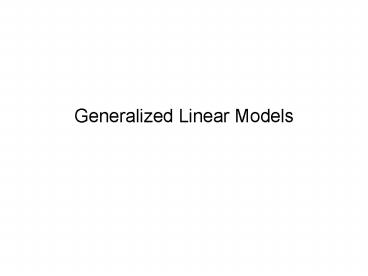Generalized Linear Models - PowerPoint PPT Presentation
Title:
Generalized Linear Models
Description:
Generalized Linear Models Generalized Linear Models (GLM) General class of linear models that are made up of 3 components: Random, Systematic, and Link Function ... – PowerPoint PPT presentation
Number of Views:40
Avg rating:3.0/5.0
Title: Generalized Linear Models
1
Generalized Linear Models
2
Generalized Linear Models (GLM)
- General class of linear models that are made up
of 3 components Random, Systematic, and Link
Function - Random component Identifies dependent variable
(Y) and its probability distribution - Systematic Component Identifies the set of
explanatory variables (X1,...,Xk) - Link Function Identifies a function of the mean
that is a linear function of the explanatory
variables
3
Random Component
- Conditionally Normally distributed response with
constant standard deviation - Regression models
we have fit so far. - Binary outcomes (Success or Failure)- Random
component has Binomial distribution and model is
called Logistic Regression. - Count data (number of events in fixed area and/or
length of time)- Random component has Poisson
distribution and model is called Poisson
Regression - When Count data have V(Y) gt E(Y), model fit can
be Negative Binomial Regression - Continuous data with skewed distribution and
variation that increases with the mean can be
modeled with a Gamma distribution
4
Common Link Functions
- Identity link (form used in normal and gamma
regression models) - Log link (used when m cannot be negative as when
data are Poisson counts) - Logit link (used when m is bounded between 0 and
1 as when data are binary)
5
Logistic Regression
- Logistic Regression - Dichotomous Response
variable and numeric and/or categorical
explanatory variable(s) - Goal Model the probability of a particular
outcome as a function of the predictor
variable(s) - Problem Probabilities are bounded between 0 and
1 - Distribution of Responses Binomial
- Link Function
6
Logistic Regression with 1 Predictor
- Response - Presence/Absence of characteristic
- Predictor - Numeric variable observed for each
case - Model - p(x) ? Probability of presence at
predictor level x
- b1 0 ? P(Presence) is the same at each
level of x - b1 gt 0 ? P(Presence) increases as x increases
- b 1lt 0 ? P(Presence) decreases as x increases
7
Logistic Regression with 1 Predictor
- b0, b1 are unknown parameters and must be
estimated using statistical software such as
SPSS, SAS, R or STATA (or in a matrix language) - Primary interest in estimating and testing
hypotheses regarding b1 - Large-Sample test (Wald Test)
- H0 b1 0 HA b1 ? 0
Note Some software packages perform this as an
equivalent Z-test or t-test
8
Odds Ratio
- Interpretation of Regression Coefficient (b)
- In linear regression, the slope coefficient is
the change in the mean response as x increases by
1 unit - In logistic regression, we can show that
- Thus eb represents the change in the odds of the
outcome (multiplicatively) by increasing x by 1
unit - If b 0, the odds and probability are the same
at all x levels (eb1) - If b gt 0 , the odds and probability increase as
x increases (ebgt1) - If b lt 0 , the odds and probability decrease as
x increases (eblt1)
9
95 Confidence Interval for Odds Ratio
- Step 1 Construct a 95 CI for b
- Step 2 Raise e 2.718 to the lower and upper
bounds of the CI
- If entire interval is above 1, conclude positive
association - If entire interval is below 1, conclude negative
association - If interval contains 1, cannot conclude there is
an association
10
Multiple Logistic Regression
- Extension to more than one predictor variable
(either numeric or dummy variables). - With k predictors, the model is written
- Adjusted Odds ratio for raising xi by 1 unit,
holding all other predictors constant
- Many models have nominal/ordinal predictors, and
widely make use of dummy variables
11
Testing Regression Coefficients
- Testing the overall model
- L0, L1 are values of the maximized likelihood
function, computed by statistical software
packages. This logic can also be used to compare
full and reduced models based on subsets of
predictors. Testing for individual terms is done
as in model with a single predictor.
12
Poisson Regression
- Generally used to model Count data
- Distribution Poisson (Restriction E(Y)V(Y))
- Link Function Can be identity link, but
typically use the log link
Tests are conducted as in Logistic
regression When the mean and variance are not
equal (over-dispersion), often replace the
Poisson Distribution replaced with Negative
Binomial Distribution






























